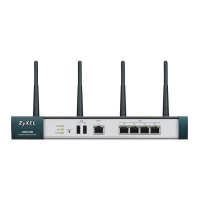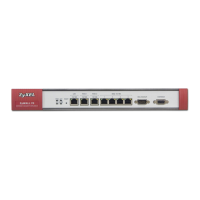Chapter 8 Home Networking
XMG3512-B10A User’s Guide
116
LAN IPv6 Mode Setup
IPv6 Active
Select Enable to activate the IPv6 mode and configure IPv6 settings on the XMG.
Link Local Address Type
EUI64
Select this to have the XMG generate an interface ID for the LAN interface’s link-local address
using the EUI-64 format.
Manual
Select this to manually enter an interface ID for the LAN interface’s link-local address.
Lan Global Identifier Type
EUI64
Select this to have the XMG generate an interface ID using the EUI-64 format for its global
address .
Manual
Select this to manually enter an interface ID for the LAN interface’s global IPv6 address.
LAN IPv6 Prefix Setup
Delegate prefix
from WAN
Select this option to automatically obtain an IPv6 network prefix from the service provider or an
uplink router.
Static
Select this option to configure a fixed IPv6 address for the XMG’s LAN IPv6 address.
MLD Snooping Multicast Listener Discovery (MLD) allows an IPv6 switch or router to discover the presence of
MLD hosts who wish to receive multicast packets and the IP addresses of multicast groups the
hosts want to join on its network.
Active
Select Enable to activate MLD Snooping on the XMG. This allows the XMG to check MLD packets
passing through it and learn the multicast group membership. It helps reduce multicast traffic.
MLD Mode
Select Standard Mode to allow the XMG to forward MLD packets only to ports that want to
receive it.
Select MLD Mode to allow the XMG to block MLD packets for a specific multicast group.
LAN IPv6
Address Assign
Setup
Select how you want to obtain an IPv6 address:
• Stateless: The XMG uses IPv6 stateless autoconfiguration. RADVD (Router Advertisement
Daemon) is enabled to have the XMG send IPv6 prefix information in router advertisements
periodically and in response to router solicitations. DHCPv6 server is disabled.
• Stateful: The XMG uses IPv6 stateful autoconfiguration. The DHCPv6 server is enabled to have
the XMG act as a DHCPv6 server and pass IPv6 addresses to DHCPv6 clients.
• Stateless and Stateful: The XMG uses both IPv6 stateless and stateful autoconfiguration. The
LAN IPv6 clients can obtain IPv6 addresses either through router advertisements or through
DHCPv6.
LAN IPv6 DNS
Assign Setup
Select how the XMG provide DNS server and domain name information to the clients:
• From Router Advertisement: The XMG provides DNS information through router
advertisements.
• From DHCPv6 Server: The XMG provides DNS information through DHCPv6.
• From RA & DHCPv6 Server: The XMG provides DNS information through both router
advertisements and DHCPv6.
DHCPv6 Configuration
DHCPv6 Active
This shows the status of the DHCPv6. DHCPv6 Server displays if you configured the XMG to act as
a DHCPv6 server which assigns IPv6 addresses and/or DNS information to clients.
IPv6 Router Advertisement State
RADVD Active
This shows whether RADVD is enabled or not.
IPv6 DNS Values
IPv6 DNS Server
1-3
Select From ISP if your ISP dynamically assigns IPv6 DNS server information.
Select User-Defined if you have the IPv6 address of a DNS server. Enter the DNS server IPv6
addresses the XMG passes to the DHCP clients.
Select None if you do not want to configure IPv6 DNS servers.
Table 29 Network Setting > Home Networking > LAN Setup (continued)
LABEL DESCRIPTION

